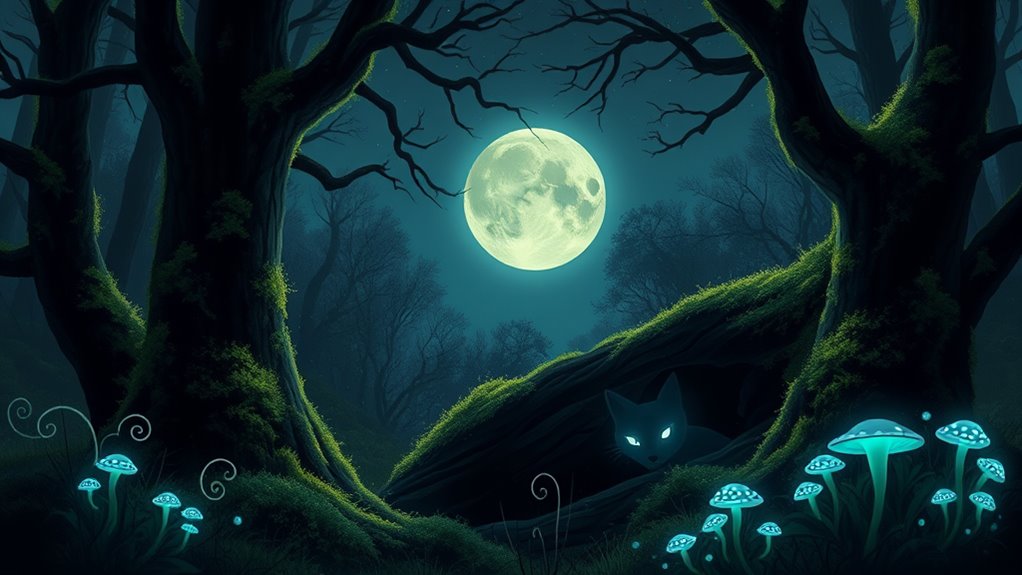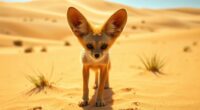The hidden world of nocturnal animals is fascinating. You've got creatures like owls and bats, which possess enhanced senses like improved night vision and acute hearing. These adaptations help them hunt effectively in low-light conditions. Many nocturnal species, such as moths, also play essential roles in pollination and pest control, supporting ecosystem health. Unfortunately, human activities threaten their habitats. Discover more about these incredible animals and the challenges they face as night falls.
Key Takeaways
- Nocturnal animals possess unique adaptations, such as large eyes and high rod cell density, allowing them to thrive in low-light conditions.
- Predators like owls and tigers utilize acute hearing and excellent night vision to effectively hunt and locate prey during darkness.
- Bats employ echolocation to navigate and find insects, showcasing an innovative strategy for survival in the dark.
- Nocturnal pollinators, including moths and bats, play a vital role in pollinating night-blooming plants, supporting ecosystem health and biodiversity.
- Urbanization, light pollution, and habitat destruction threaten nocturnal wildlife, necessitating conservation efforts to protect these species and their environments.
Unique Adaptations for Low-Light Survival
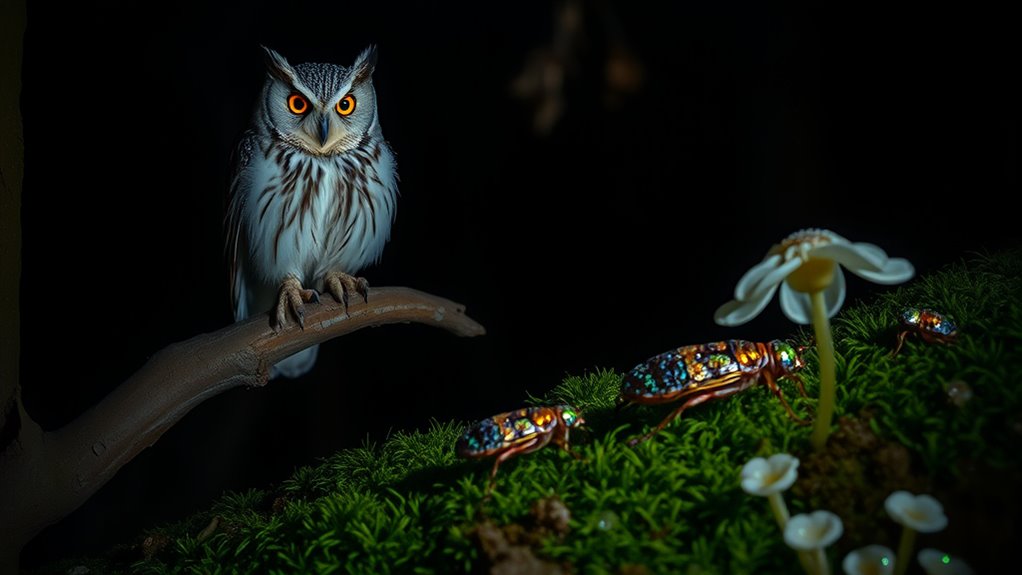
When you think about survival in the dark, nocturnal animals showcase remarkable adaptations that make them masters of low-light environments. Their large eyes, packed with rod cells, capture more light, allowing them to see clearly when the sun goes down.
Take owls, for instance; their acute hearing helps them detect even the faintest rustle of prey. Bats rely on echolocation, emitting high-frequency sounds that bounce off objects, guiding them through the night sky.
Tigers, with their excellent night vision, can stalk silently through dim forests, ensuring they remain undetected. Additionally, owls can rotate their heads nearly 270 degrees, giving them an edge in locating prey.
These unique adaptations prove essential for survival in the darkness of night.
Enhanced Senses: The Key to Nocturnal Hunting
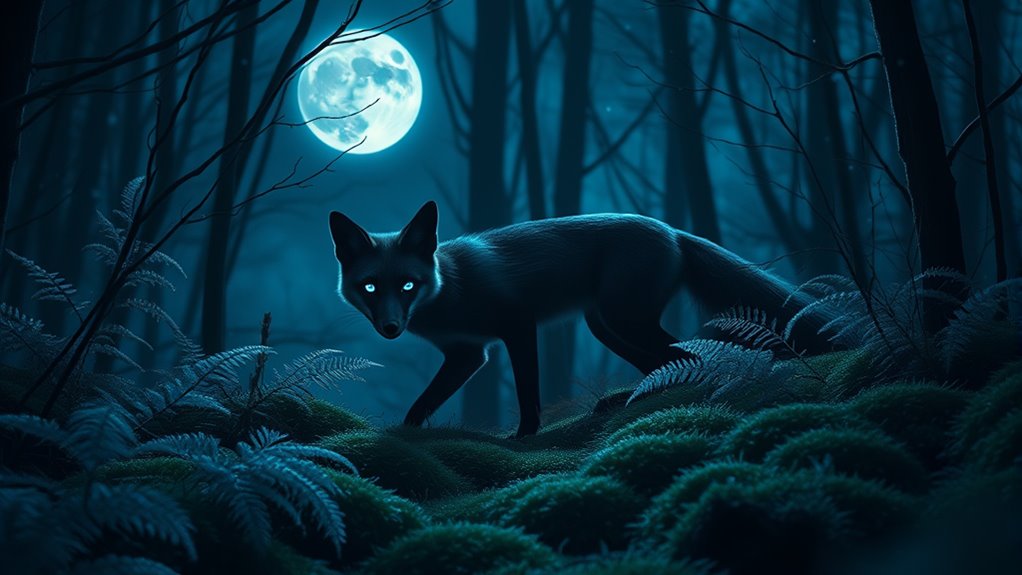
As night falls, nocturnal animals rely on their enhanced senses to hunt effectively in the darkness. With acute hearing, they detect even the faintest movements of prey.
Take owls, for instance; their specialized ear structures help pinpoint sound locations, leading to successful captures. Bats, on the other hand, employ echolocation, emitting high-frequency sounds that bounce back, revealing the location of insects in total blackness.
Many nocturnal creatures also possess larger eyes rich in rod cells, allowing them to gather more light and see in dim conditions. This combination of heightened senses not only aids in stalking prey but also reduces competition with daytime hunters, ensuring their survival and dominance in the night.
Hunting Strategies in the Dark
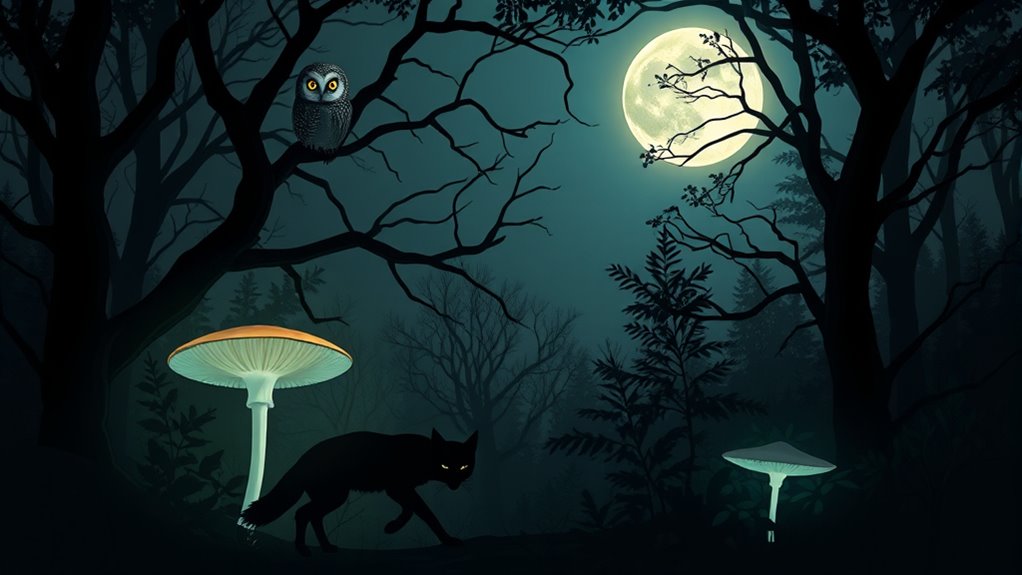
When you think about hunting in the dark, consider how nocturnal animals adapt their strategies for success.
From using enhanced night vision to employing echolocation, these creatures have mastered the art of nighttime hunting.
Night Vision Adaptations
Nocturnal animals thrive in darkness, thanks to their remarkable night vision adaptations. Their large eyes, packed with rod cells, help them capture more light, allowing you to see better in low-light conditions. Predators like owls and tigers have developed exceptional night vision, enabling effective stalking of prey. For instance, owls can rotate their heads nearly 270 degrees, honing in on sounds without moving their bodies. This enhances their hunting efficiency. By synchronizing their activity patterns with prey movements, nocturnal hunters maximize their chances of success while conserving energy.
| Animal | Adaptation |
|---|---|
| Owls | 270-degree head rotation |
| Tigers | High rod cell density |
| Bats | Echolocation (not discussed) |
| Foxes | Camouflaged fur |
| Raccoons | Sensitive night vision |
Echolocation Techniques
While many nocturnal animals rely on enhanced vision to hunt in the dark, bats have mastered a different approach: echolocation. They emit high-frequency sounds and listen for echoes bouncing back from objects, allowing them to navigate and locate prey in total darkness.
This biological sonar helps you detect the size, shape, distance, and even texture of objects, making bats incredibly accurate hunters of insects. Depending on the species, bats can emit sounds as high as 100 kHz, beyond human hearing.
Notably, echolocation isn't limited to bats; dolphins and certain birds like oilbirds and swiftlets also use this technique. Bats rapidly process these signals, adjusting their flight paths and strategies in real-time, solidifying their role as effective nocturnal predators.
Prey Timing Strategies
As dusk settles in, many nocturnal predators begin to strategize their hunts, timing their activities to match the peak movements of their prey.
They've adapted their skills to maximize success during these critical hours. Here's how they do it:
- Enhanced Vision: Predators like tigers use excellent night vision to stalk and ambush prey effectively when it's most active.
- Optimal Timing: Animals such as owls hunt at dusk and dawn, coinciding their activities with small mammals and insects, which are also moving around.
- Energy Conservation: Nighttime hunting allows predators to conserve energy, as cooler temperatures reduce caloric expenditure compared to daytime activities.
These strategies highlight the fascinating adaptations of nocturnal animals in their quest for survival.
Environmental Adaptations of Nocturnal Species
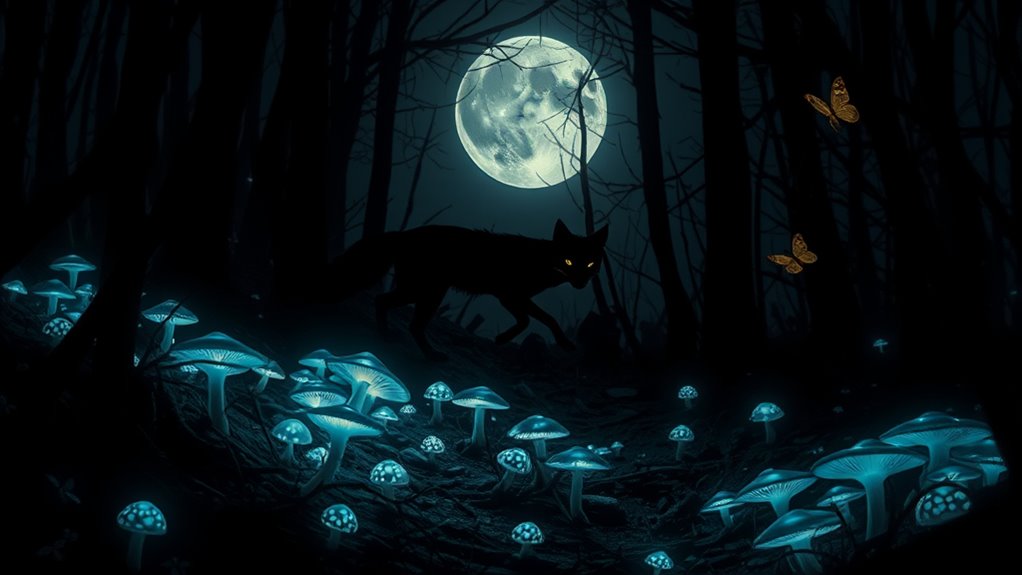
When you think about nocturnal animals, consider how they've adapted to survive in challenging environments.
They conserve energy and have unique physiological traits that help them thrive at night.
Plus, their behaviors are finely tuned to maximize their chances of finding food while minimizing risks.
Energy Conservation Techniques
Nocturnal animals have developed a range of energy conservation techniques that allow them to thrive in their nighttime environments.
By adapting to the dark, these species maximize their energy efficiency in various ways:
- Reduced Metabolic Rates: Many reduce their metabolic rates during the day, resting in cooler, shaded areas to conserve energy.
- Nocturnal Activity: Animals like desert foxes and kangaroo rats are active at night, avoiding the heat of the day, which helps maintain hydration and energy levels.
- Efficient Hunting Strategies: They've honed their hunting tactics to capitalize on reduced visibility, allowing them to expend less energy while foraging.
Through these techniques, nocturnal animals effectively balance their energy use with the demands of survival.
Physiological Night Adaptations
While maneuvering through the challenges of darkness, many nocturnal species have evolved remarkable physiological adaptations that enhance their survival.
You'll notice that these animals often have larger eyes packed with rod cells, allowing them to capture more light in dim conditions. Their unique tapetum lucidum reflects light through the retina, boosting night vision even further.
To thrive in the cooler night air, many develop better body temperature regulation, enabling activity without overheating. Plus, a slower metabolism helps conserve energy during nighttime foraging, vital when food is scarce.
These adaptations not only enhance their survival but also showcase the incredible resilience of life in the dark, allowing you to appreciate the wonders of nocturnal existence.
Behavioral Survival Strategies
Many nocturnal species have developed behavioral survival strategies that complement their physiological adaptations. By being active at night, they conserve energy and avoid the extreme heat of their environments.
Here are three key strategies they use:
- Timing of Activities: Animals like desert foxes and kangaroo rats hunt and forage during cooler nighttime hours, reducing competition and predator encounters.
- Hunting Techniques: Nocturnal predators, such as tigers, align their hunting times with the activity patterns of prey, guaranteeing greater success in capturing food.
- Navigation Skills: Species like bats use echolocation, while owls rely on sensitive hearing to navigate and hunt in the dark, making them formidable nighttime hunters.
These strategies not only enhance survival but also guarantee that nocturnal animals thrive in their unique habitats.
Ecological Roles of Nocturnal Animals
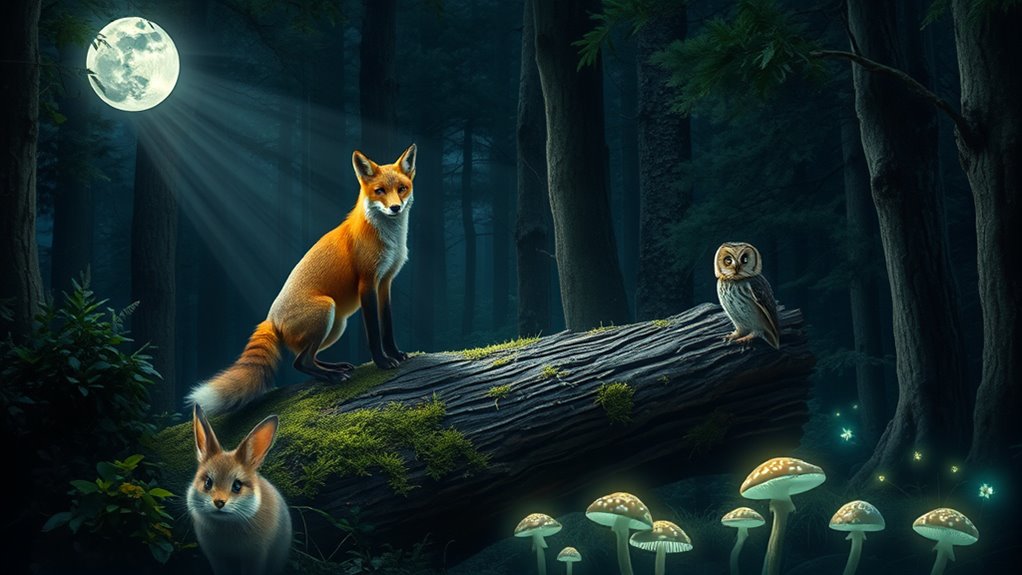
Although often overlooked, the ecological roles of nocturnal animals are essential for maintaining healthy ecosystems.
These animals, like owls and bats, help control pest populations, reducing crop damage and keeping insect numbers in check. Meanwhile, creatures such as raccoons and foxes contribute to seed dispersal, transporting and burying seeds during their nighttime foraging, which enhances plant diversity.
Additionally, nocturnal predators maintain the balance of ecosystems by preying on smaller animals, preventing overpopulation and supporting various food webs.
When nocturnal animal populations face disruption, it can lead to ecological imbalances, negatively impacting not just their prey and plant species, but also the overall health of the ecosystems they inhabit.
You can see their significance in every corner of nature.
The Importance of Nocturnal Pollinators
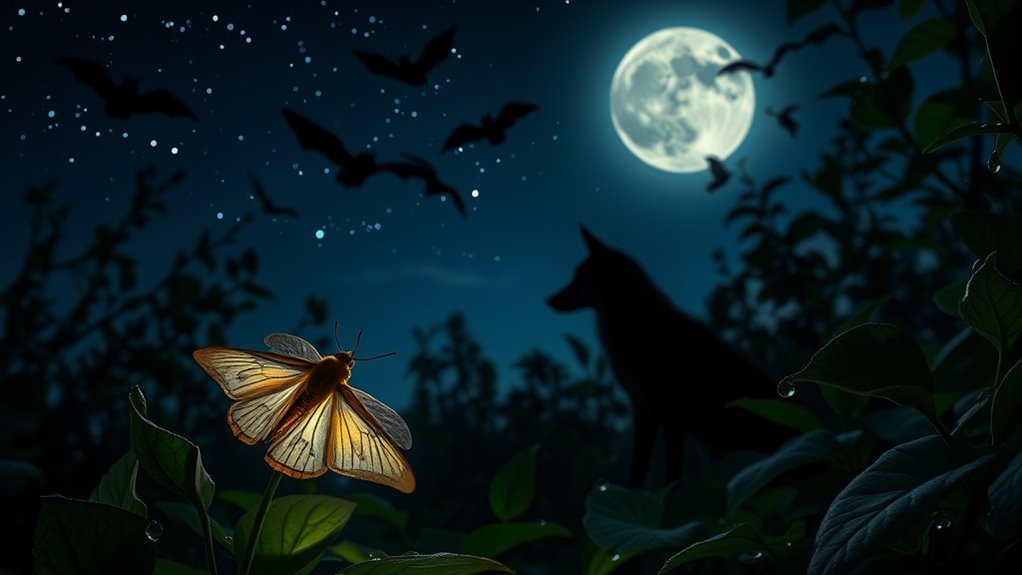
Nocturnal pollinators, such as moths and bats, greatly contribute to the health of our ecosystems, especially when it comes to the reproduction of night-blooming plants.
These creatures are essential for maintaining plant diversity and ensuring ecological balance. Here are three key reasons why they matter:
- Pollination of Night-Blooming Plants: About 30% of flowering plants rely on nocturnal species, including cacti and moonflowers, for pollination.
- Crop Support: Moths, like sphinx and hawk species, play critical roles in pollinating important crops such as tomatoes and tobacco.
- Pest Control: By feeding on nectar, nocturnal pollinators help control pest populations, supporting agricultural productivity.
Protecting these pollinators is fundamental for preserving biodiversity and the health of our ecosystems.
Nighttime Predators and Their Prey
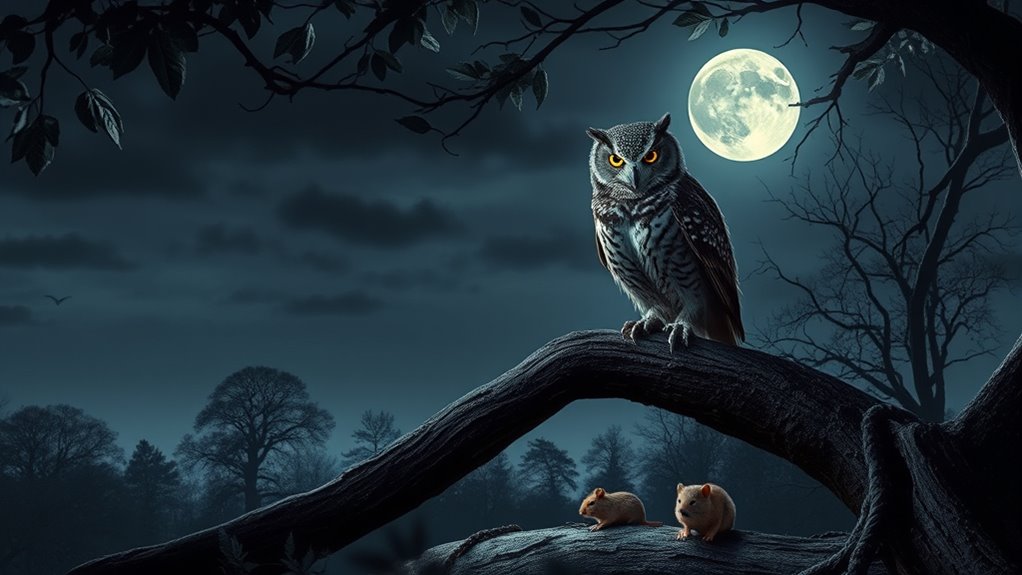
While the darkness of night often brings a sense of calm, it's also when a variety of predators become active, hunting for their next meal.
Owls, with their specialized vision, can spot prey in low light and rotate their heads nearly 270 degrees to widen their search.
Owls possess remarkable vision, enabling them to hunt in low light and rotate their heads nearly 270 degrees for optimal prey detection.
Bats use echolocation, emitting high-frequency sounds to locate insects in complete darkness.
Tigers, though mainly active during the day, excel at night with their sharp night vision, allowing them to stalk and ambush unsuspecting prey.
These nocturnal hunters time their activities with the patterns of their prey, ensuring they strike when their targets are most vulnerable.
The Impact of Human Activities on Nocturnal Habitats

As nighttime predators rely on their specialized skills to hunt, human activities increasingly threaten their habitats. Urbanization and habitat destruction lead to a significant decline in nocturnal species.
Light pollution disrupts their natural behaviors, impairing hunting and mating. You might be surprised by how these factors converge to impact these elusive animals:
- Habitat Loss: Development and agriculture eliminate natural environments, forcing nocturnal species to adapt or perish.
- Light Pollution: Artificial lighting alters behaviors, making it harder for animals to find food and mates.
- Chemical Exposure: Pesticide use reduces food sources and exposes nocturnal animals to harmful substances.
These challenges underscore the urgent need to reconsider our impact on nocturnal habitats and take action to preserve these essential ecosystems.
Conservation Efforts for Nocturnal Wildlife

To protect nocturnal wildlife effectively, conservation efforts must prioritize habitat preservation and restoration. Many species face threats from urban development and habitat fragmentation, disrupting their natural behaviors.
You can support initiatives that create wildlife corridors, allowing safe passage for breeding and foraging. Participating in research programs that monitor nocturnal populations helps identify essential conservation areas. These initiatives target threats like light pollution, which disrupts their natural rhythms.
Community involvement is important; by raising awareness, you can advocate for reducing outdoor lighting and promoting wildlife-friendly landscaping in your area.
Additionally, international cooperation is significant for protecting migratory nocturnal species, as their survival often relies on safeguarding multiple habitats across different regions and countries.
Together, we can make a difference.
Frequently Asked Questions
What Actually Happened in Nocturnal Animals?
In the world of nocturnal animals, you'll find fascinating adaptations that help them thrive in the dark. Their enhanced night vision, large eyes, and specialized hunting techniques, like bats' echolocation, make them efficient predators.
Why Did He Not Show up at the End of Nocturnal Animals?
Did you know that about 70% of people experience unresolved issues in their relationships?
In "Nocturnal Animals," Edward's absence at the end is a deliberate choice, symbolizing the emotional turmoil and regret that lingers in Susan's life.
His non-appearance highlights her internal conflict and the consequences of past decisions.
It leaves you questioning the nature of love and betrayal, emphasizing the haunting memories that shape their connection without a direct confrontation.
What Did Susan Do to Edward in Nocturnal Animals?
In "Nocturnal Animals," you see Susan Morrow hurt Edward Sheffield deeply by leaving him.
Her decision to end their marriage not only shattered his heart but also set off a chain of emotional turmoil for both of them.
As she reads his manuscript, you witness her grappling with guilt and regret over her actions.
It's a powerful reflection of the pain she inflicted and the complex dynamics of their relationship.
What the Heck Is Nocturnal Animals About?
Nocturnal animals embody the mystery of night and the vibrant life hidden in darkness.
It's about how these creatures, like owls and bats, thrive in low light, using sharpened senses and unique skills.
You'll discover their strategies for hunting and survival, while also seeing the challenges they face from habitat loss and human activity.
Ultimately, it's a fascinating exploration of their roles in nature's delicate balance, showcasing both beauty and vulnerability.
Conclusion
So, next time you're out at night, just remember: while you're binge-watching your favorite show, countless nocturnal animals are busy keeping ecosystems in check. Ironically, you might think the dark is just for sleep, but it's actually a bustling world of life and survival. As you cozy up indoors, consider how your actions impact these hidden creatures. After all, they're working hard while you're off dreaming about them!
